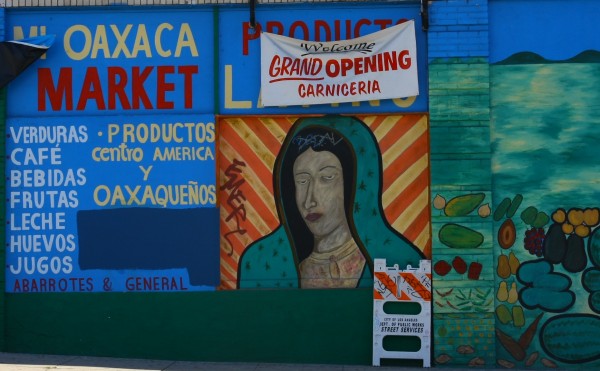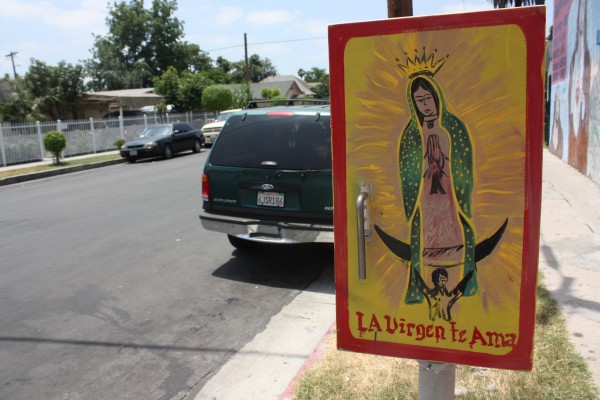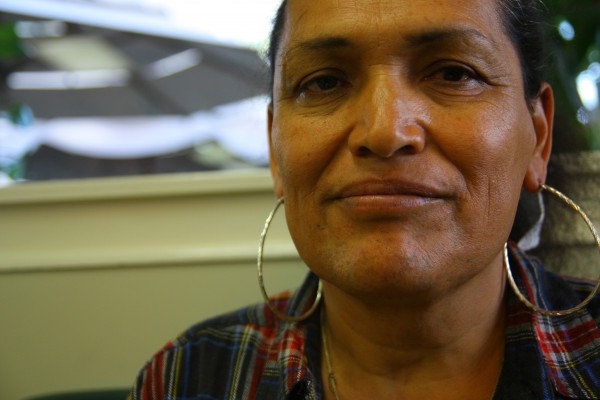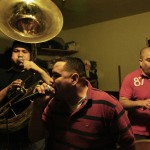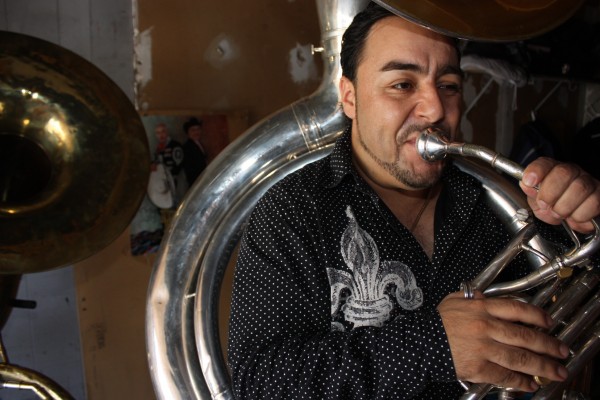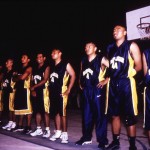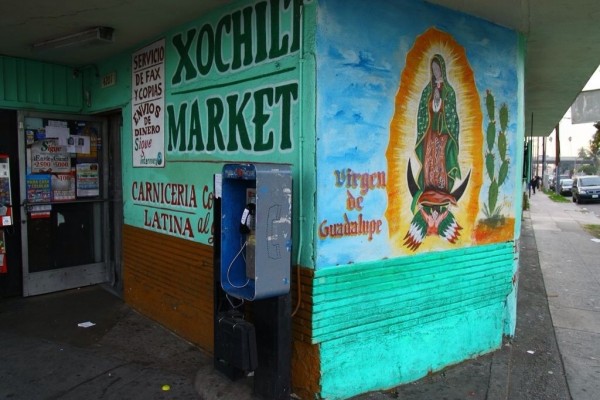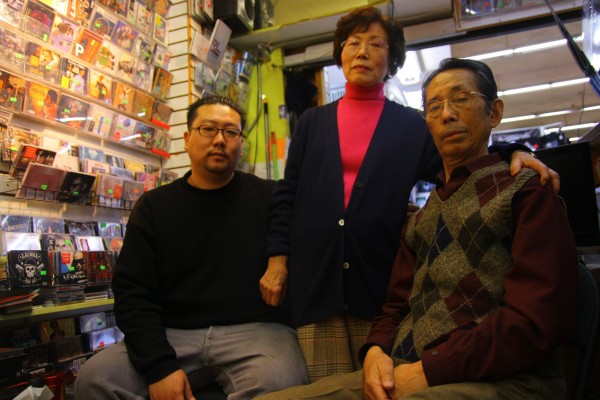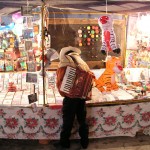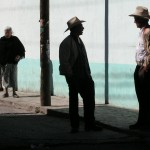Category Archives: Migrants
STREETS: Virgin of the Carniceria
Filed under Los Angeles, Migrants, Streets, Virgin
STREETS: `It’s like Vietnam around here’
Earlier today, I was covering the aftermath of the shooting/fire in East Hollywood that took the lives of two people (the shooter being one) and left four people wounded Thursday afternoon. (Here’s the LAT story)
I was leaving when I was approached by Sherman Werner, the self-proclaimed “only Anglo for three miles around,” which I believe, as East Hollywood is largely Central American, Mexican (Oaxacan mostly), Filipino, Thai and others.
Mr. Werner, turns out, lived in Porter Ranch then sold his house and moved into an apartment building he owned seven years ago, a few blocks from the fire/shooting.
One of the interesting parts of LA scenery are the last remaining Anglos in areas that have gone through enormous demographic change and are now largely immigrant communities. From these folks, whom I’ve occasionally come across, you’re likely to get a highly unvarnished view of things.
Mr. Werner was no different, commenting on the women, the numbers of murders — “One there, one next door to me, now this one, and they’re all about infidelity.” He was wearing no shirt — of course not. he’s 71. who’s he got to impress any more? — and his dogtags from his Marine days.
In 1965, he was drafted, on Lyndon Johnson’s birthday and sent to Vietnam,which he compares to the neighborhood where he now resides. “I haven’t seen this much action since the Vietnam War,” he told me.
He had choice words for the MS gang whose graffiti we saw a few yards away. He had that horse laugh of a long-time smoker, and showed me where he’d taken shrapnel. I hardly had to do any talking.
Filed under Los Angeles, Migrants, Southern California, Streets
STREETS: More on transgender style and Latinas
I love my job. Yesterday I was talking with Brenda Gonzalez, a transgender woman from the state of Michoacan, who works in Hollywood. I’d gone to her nonprofit service agency because they host a meeting of Latina transgender women every Wednesday.
Anyway, we were talking more about the case of the transgender woman, Nathan Vickers (or Cassidy, or Chassidy), who was murdered in November and again the topic turned to how Latina immigrants, mostly from Mexico, had changed transgender culture.
As I’ve written here in an earlier post, Latinas dove into surgery in a big way. Part of it, Brenda told me, was due to the fact that they were illegal and had no work and street was all that was available and guys with large breasts, high cheeks, round buttocks made more money. It was also because many came looking for a transformation that was denied them in Mexico — much like other immigrants, from small, benighted villages.
“Part of the transition is transforming yourself emotionally, spiritually, and physically. You have to be beautiful, up to date, you have to look beautiful, sexy, voluptuous,” she told me.
But with so many girls in the same situation, all competing on the street, “part of the competition becomes obsession. You see some little Lupita on the corner with a new nose, then you want one. If she gets a nice bust, you want one, and now not just size 40, but 44dd.”
Plus, their world is very small, she said. “I live in East LA but I hear when someone in Hollywood gets an operation. If I live in Hollywood, I hear when someone Long Beach gets operated or someone in Van Nuys gets a sex change.” So that adds to the demand for surgery.
Most important are breast implants. Breasts being the most obvious sign of being female, implants are the transgender’s American Dream, Brenda said.
“Part of the transition and acceptance and feeling happy and content with ourselves, what makes us feel even more secure and more like women, is when we have breast augmentation. It’s why most of us have our breast surgery. Some view it from the sex market: There’s more demand for those who have them, and then you can then get more surgery and send money home to mom and dad. It’s a fundamental part of the transition that make you feel secure are implants, breast surgery that gives you a large and beautiful bust. It’s part of your own feeling of security. It’s essential.”
Man, you just don’t hear this kind of stuff that often.
Sorry no photos from the interview. So here (above) are a few when I lived with the girls in Mazatlan as they prepared for what was then the oldest gay beauty contest in Mexico (from my first book), including one who is getting her breasts injected with baby oil, which was the only method they could afford on the money they made hooking down in Mazatlan.
Filed under Los Angeles, Mexico, Migrants, Streets
LOS ANGELES: Valentine’s sales
I was coming out of an interview this afternoon and headed to lunch when I came upon a vendor named Maria, from the town of Mitla, Oaxaca, selling Valentine’s flowers and gifts at Santa Monica and Western.
We had a long chat, after I bought some flowers. As festive as Maria and the women selling with her looked, Valentine’s Day to them was less about love than desperation.
After 25 years in the United States, working as a maid, Maria told me she’s been without domestic work for months. Her construction-worker husband is down to only a couple days work in the best of weeks.
So a few days ago, she and a battalion of women went downtown to the Toy District for Hello Kitty dolls. She spent the next few days assembling Hello Kitty Valentine’s packages, and was now selling them from between $10 to $20 each. Then, she went to the Flower District downtown, bought flowers in bulk, and put them together in bouquets for $20 apiece.
“I really haven’t done this before, and it doesn’t make a lot of money, but what else do I have,” she told me, standing at the busy and sun-splashed corner Tuesday afternoon, surrounded by women, unemployed maids, just like her and selling the same kind of stuff.
Reports are that the economy is returning. Remittances to Mexico from immigrants in the United States are up. Maria and her friends at Santa Monica and Western don’t see it.
A friend, who gave her name only as Magdalena, pointed to a 99-cents store on Santa Monica that closed and was replaced recently by a swap meet, which she helped open. Still, “there’s just no business,” said Magdalena, an unemployed maid and a migrant from the tourist resort of Acapulco.
Maria figured to be out selling until 6 pm, hoping to get rid of the flowers and Hello Kitty dolls she bought. She’s worried, though, because Friday her landlord filed eviction papers from the house she and her husband have rented for 18 years and raised her four children when they couldn’t pay the rent on time. they’d been late before, apparently, and it appears this time her mother fell and required stitches, so the rent had to wait.
“We’re thinking of going back home,” she told me as I was leaving.
Filed under Los Angeles, Mexico, Migrants, Streets
LOS ANGELES: Solitary Virgin
Here again, another in my attempt to photograph every Virgin of Guadalupe in South LA.
This one was just off Compton Boulevard, painted on what had once been a payphone casing.
If you have photos of the Jefa you’d like to put up, please send them in — doesn’t matter where from….
Filed under Culture, Los Angeles, Mexico, Migrants
STREETS: Latinas and transgender style
As I wrote earlier, I’ve been doing a story on the murder of a transgender black woman named Nathan Vickers, who also went by the names Chassidy, Chase and Cassidy.
I believe homicide gives reporters an opportunity to write about how a person lived, and less about how she died. As part of that, I’m trying to write about the transgender prostitute subculture in Hollywood.
One person I talked to was Luisa Rivera, a transsexual who has lived here for many years and who comes from Guadalajara. Latina transgenders changed a lot about the culture, which was really about drag queens until they arrived. They began coming in large numbers in the 1980s, mostly from Mexico, she said. As it happened, this coincided with the emergence of plastic surgery, which kept dropping in price as the years passed.
Far more so than other groups, Latina transgenders went for plastic surgery in a big way, she said. Enormous breasts, cheek and buttock implants, lots of silicon and hair weaves. Rivera said. In Hollywood they had surgeons here and in Tijuana to choose from. (They also had a vast, monied john clientele here, who insisted that they remain “fully functional” men, as the back-of-the-book ads in Hollywood sex throw-aways relentlessly put it.)
As we spoke, it occurred to me that Mexican transgenders were very much like other Mexican immigrants, but with a twist.
Mexican immigrants, generally, have spent the first dollars they’ve earned here in establishing themselves back home, mainly by building large houses. So it’s not only a house; it’s a way of showing everyone else how the person has done, that he is no longer the humble, shoeless kid who left the village at 15, who was humiliated for simply being poor. His transformation is complete.
Mexican transgender women also come here for a transformation — wanting to live as women after years of beat-downs and humiliations. They, too, want to show success publicly and quickly. Instead of houses, they spend on their bodies, to show the world, and maybe themselves, that they are not who they were when they were run out of their hometowns and country. Their breasts especially are monuments (pardon the pun, if that’s what it is) to the person they have become and always wanted to be back in Mexico.
Very much enjoying this story. More interviews to come.
Filed under Los Angeles, Mexico, Migrants, Streets
CULTURE (kind of): SNL spoofs tuba thefts
This is getting weird. SNL’s Weekend Update riffed off the stolen tuba story last night. Here’s the full show, check it out at minute 35 or so.
As it happens, I missed it. By weird coincidence, I was out last night at a rehearsal of a banda of guys calling themselves Los BuKnas de Culiacan (that would be a bastardization of Buchanan, the rum), in a garage in Downey (see photos above). Buchanan Rum is a prized drink in the Mexican narco world — a sign of class and having arrived.
One of the songs was “Si No Vienes Conmigo” — which involves a man threatening his girlfriend that if she doesn’t come with him, he’s going to kidnap her and not charge a ransom. Where’s the romance gone?
Actually the band is a mixture of banda and norteno — with tuba, baritone horn, plus accordion — and looks to me a lot like the beginnings of punk rock. Went to the club where they were playing after the rehearsal and they wouldn’t let me and two BBC colleagues in. Reporters strictly prohibited at El Potrero Club in Cudahy.
Filed under Los Angeles, Mexico, Migrants, Uncategorized
MIGRANTS: Tuba thefts
The LA band craze continues to claim high school tubas right and left.
Here’s a link to a story about the latest: Bell High School had two stolen over the weekend, valued at $6,000 apiece. Several other schools have had tubas stolen in recent months.
It’s all about the emergence of the tuba as the emblematic instrument for Southern California in this era, just as the electric guitar was for the 1970s.
With the arrival of Mexican immigrants, and their tradition of house parties, the tuba has become all the rage in SoCal. Great tubists in banda music, like Santiago Mata (pictured here), are paid more than other musicians.
Also, the Sierreno trio — tuba, guitar and accordion — has grown in popularity at these parties.
Hence, tubas, the most expensive of marching band instruments, are in high demand. Most of the thefts have taken place in predominantly Mexican immigrant areas — southeast of LA especially — where banda is hugely popular.
I’ve written a story about this phenomenon and one about the thefts of tubas that many instructors believe is the result.
Filed under Los Angeles, Mexico, Migrants
MIGRANTS: Zeus Garcia, the Michael Jordan of Oaxacan Indian basketball
I had lunch the other day with an old friend, Zeus Garcia.
In his day, Zeus was like the Michael Jordan of Oaxacan Indian basketball – this in the mid-1970s. He and his brothers and cousins formed a basketball team from their village outside the City of Oaxaca and won tournaments for miles around for years. In the 1980s, they all migrated to LA., part of a large Zapotec Indian migration to the area that really heated up during those years. Almost all of them moved to either Pico-Union or Mar Vista or Venice. (More on why not East LA in a later post.)
Zeus, when I first met him in the late 1990s, was a bus boy and intent on bringing a purer form of basketball to the United States, which he felt had corrupted the sport he loved. He coached a team of Oaxacan all stars, which he called Raza Unida.
Oaxacan Indians are basketball-obsessed folks and the sport plays an enormous role in their lives here in Southern California. Tournaments take place almost every weekend somewhere in the LA area. Zeus was kind of the guru of Oaxacan Indian basketball here. I wrote about him in my first book, True Tales from Another Mexico. I later went to the Copa Benito Juarez in Guelatao, Oaxaca, and watched 7000 people take in the tournament at a small outdoor court in the birthplace of the legendary Mexican president, who was Zapotec.
Zeus is now a truck driver delivering for a fruit and vegetable wholesaler near downtown L.A. He told me his brother, Isaias, himself a great basketball player in his day, last year returned to their village to take on a servicio – a public job that is unpaid and that each member of an Indian village must do if he wants to remain in good standing. Some who’ve refused have had their lands taken. Zeus was full of stories of how folks back home seemed from another world to Isaias, mired in gossip and unwilling to try new things or work hard.
This is the story of many Mexican villages, seems to me. The ones with the drive and gumption leave. Those left behind depend on the dollars sent down from El Norte, and the result is a kind of welfare dependency that drives a lot of returning immigrants nuts.
I may do that story. Keep you apprised as it goes along.
Photos: Zeus Garcia then and in 1999, and two shots of village teams from the Copa Benito Juarez.
Filed under Los Angeles, Mexico, Migrants
Pay Phone Virgin – Broadway & 42nd
Another in my campaign to shoot every Virgin of Guadalupe in LA. This one protects the last pay phone in town.
Filed under Los Angeles, Mexico, Migrants, Streets, Virgin
MIGRANTS: Wan Joon Kim
I’ve spending time with Wan Joon Kim and his son Kirk. Mr. Kim was a gangster rap empresario in Compton, selling records, then cassettes, of the rap pioneers from that town when no one else would, and operating it all out of a stand at an indoor swap meet.
The story began as a piece about indoor swap meets and how in Los Angeles they’ve become an avenue that thousands of Korean immigrants have used to work their way into America, selling whatever anyone would buy. They pioneered the indoor swap meet and most vendors in indoor swap meets are still Korean, though new immigrants find their way into many other businesses nowadays.
Mr. Kim just happened to sign a lease in Compton at a time when it was a hive of DIY rap artists and promoters who had nowhere else to sell their stuff. He didn’t care what he sold so long as it was different and moved. He became “Pops” to an entire generation of young Compton rappers, and had 20 years of great sales, until computer downloads began the decline of the record store. Great story, I think. Very happy I happened on it. Here he is with his son and wife….
Filed under Migrants, Uncategorized
Jaripo, Michoacan
Speaking with people from Jaripo, Michoacan comes news that the small town now has a cell of the La Familia camped out and controlling access.
They apparently drive around armed and with walkie-talkies, questioning any who enter the town.
This is sad.
Jaripo is a small, sweet town in northern Michoacan, largely deserted. Most natives have moved to the United States — Chicago, Dallas, Stockton, Santa Ana and other places. It’s inhabited mostly by empty houses, built by migrants through the 1980s-90s, when they returned every year for Christmas.
I wrote about the town in Antonio’s Gun and Delfino’s Dream — a place of clean air and quiet, except at fiesta time, when it filled with folks from the US and their trucks and mariachi bands brought in from Guadalajara.
Few return any more. Its only new residents, I’m told, are folks deported: for DUI or felony reentry into the US; a few for more serious stuff. Some of the latter have formed an alliance with this La Familia cell, I’m told.
But Jaripo lies on a paved road between Apatzingan in Michoacan’s Tierra Caliente (Hot Land), which is home to a robust drug trafficking culture that spawned La Familia, and Guadalajara. So this isolated place has become a strategic point in Mexico’s inter-cartel drug wars.
(Btw, a lot has been written about La Familia Michoacana — a pseudo-Catholic narco clan, who present themselves as defenders of Mexico against drug traffickers and smuggle large quantities of meth into the US. They have allied with the Sinaloa Cartel lately in a battle with the Zetas. They appeared to be on the decline since the arrest and death of several of its leaders in the last year or so. )

